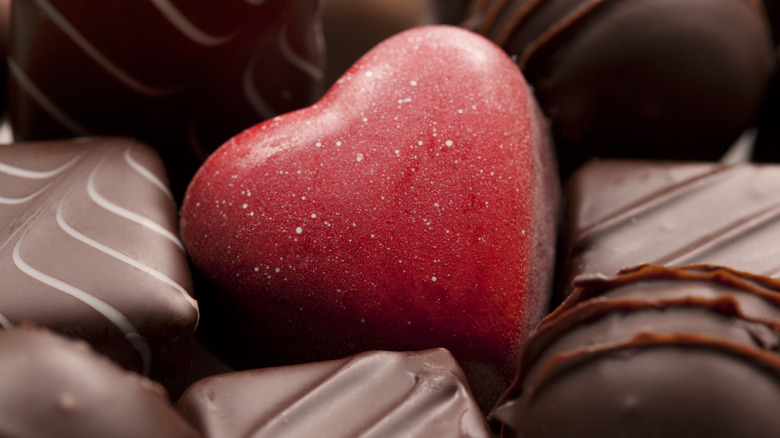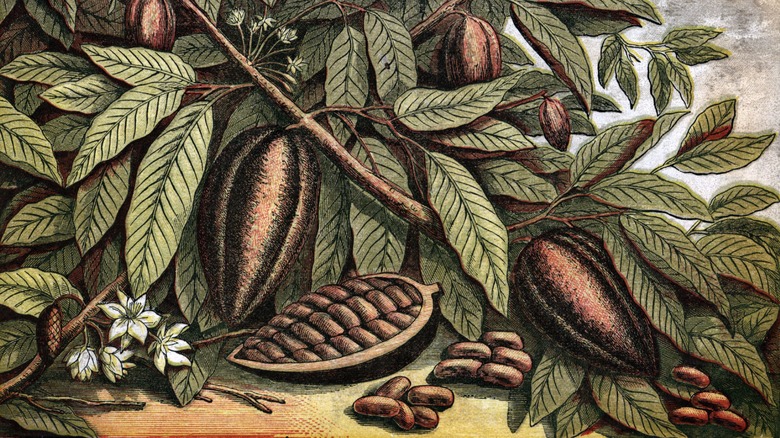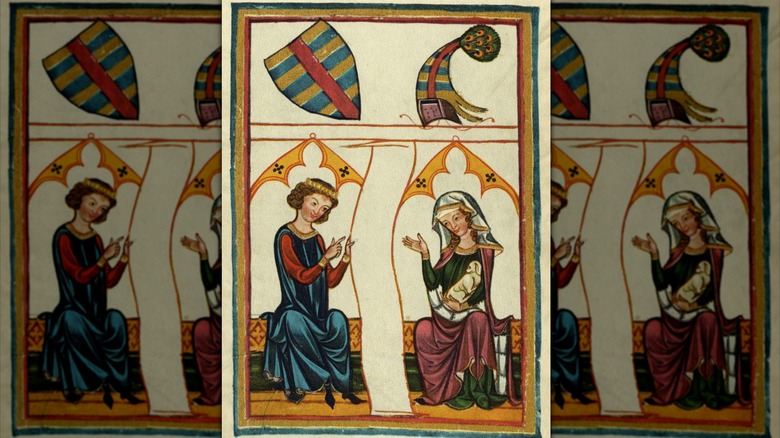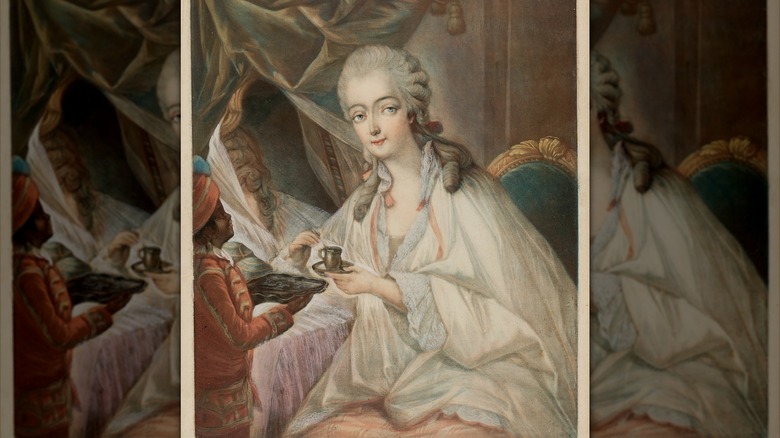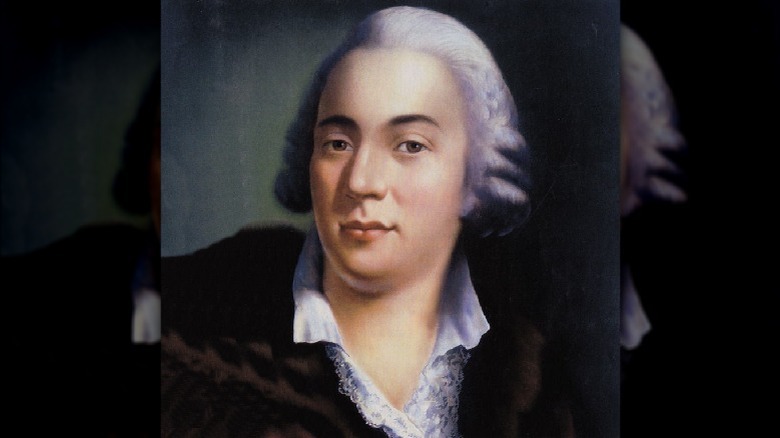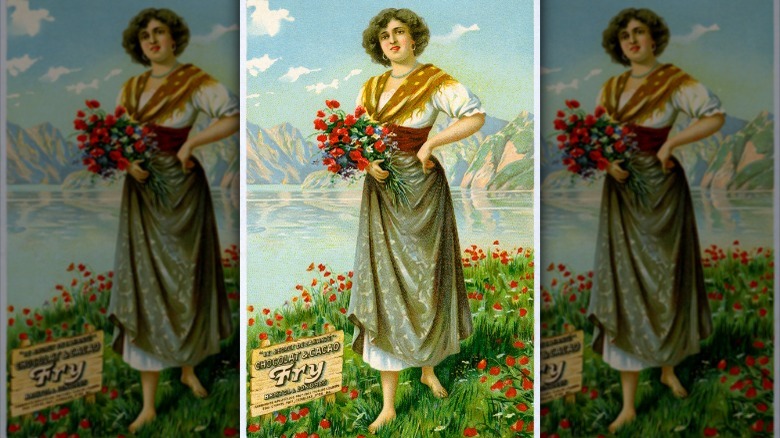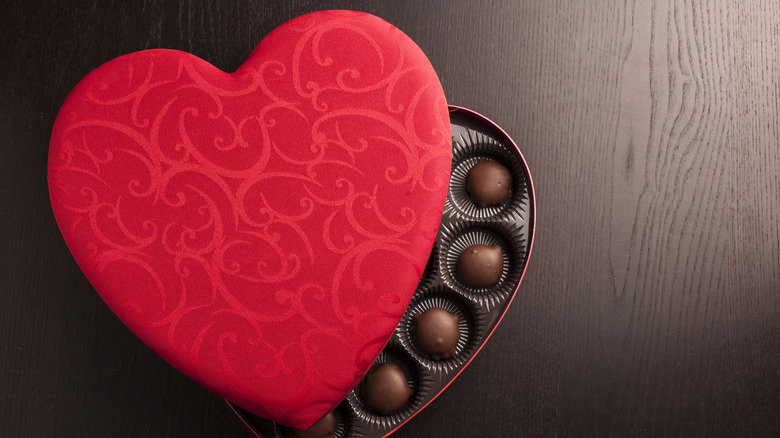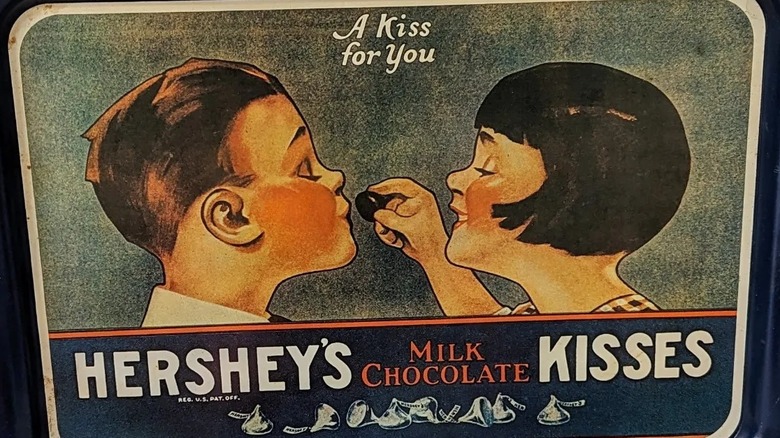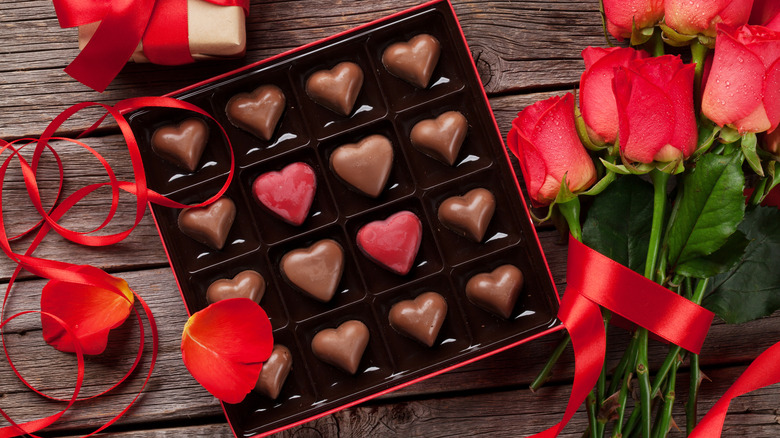The Tradition Of Valentine's Chocolates Is Older Than You Think
Though heavily commercialized today, the connection between chocolate and romance has ancient origins. Fueled by legends of cocoa's power to inspire desire, chocolate, in its various forms, was the love potion of choice for many of history's most infamous lovers. The origins of Valentine's Day are comparably ancient.
Though the exact why and how of the celebration's namesake remain a mystery, February 14 has been known as St. Valentine's Day since the fifth century. This date didn't become associated with love until the Middle Ages, when a new era of poetry created a culture of romance. Though love letters and poems have been exchanged between lovers since then, it was in the Victorian Era that chocolate became a widespread means of sharing sweet sentiments, too.
More than 150 years later, chocolate is perhaps the most emblematic gift for Valentine's Day. Even if this sweet's reasons for this association have a commercial provenance, it also perpetuates a longstanding legacy of chocolate's associations with romance.
Chocolate may have been an ancient aphrodisiac
First cultivated and consumed in Mesoamerica, chocolate has had powerful significance since ancient times. The Maya considered it to be a sacred food, and cacao became a form of currency as well as a regular offering to the gods. But when preparing cacao for consumption, the beans were typically ground and mixed with spices to create a piquant hot cocoa-adjacent drink. Referred to as xocoatl by the Aztecs, it was enhanced with local flavorings such as vanilla and chiles, making an elixir that was typically more bitter than sweet. This spicy concoction also became a representation of chocolate's logistical association with romance, as during Mayan marriage ceremonies, the bride and groom would share the beverage. The cacao crop itself was so highly valued that it was also used as part of brides' dowries.
While cacao was important to Mesoamerican culture, it is less certain whether chocolate was also regarded as medicinal. Many myths suggest that chocolate was consumed for its energy-enhancing properties, and still more declare that cacao was considered an aphrodisiac. Chocolate left a significant impression on the Spanish conquistadors who invaded South and Central America in the 1500s. Some of them purportedly witnessed Aztec emperor Montezuma II's hearty consumption of xocoatl, which contributed to legends that chocolate was the secret to how he fueled his many affairs. Whether or not chocolate truly bestowed such powers, the conquistadors imported its acquired taste and storied legends to Europe.
Medieval courtly love stories were sweet without the sugar
Sugar came to Europe long before cacao, making its debut as one of the not-so-just desserts of the Crusades, brought back by knights returning from the Middle East. But sugar was only an expensive luxury treat at first. For this reason, sweets did not define the courtly love stories of the medieval era, which became popular during and after the Crusades. Originating in the outpouring of French romantic poetry from the Middle Ages, this phenomenon quickly spread across the royal courts of Europe. It was a new genre of romance, with love stories that circumnavigated the economic and political pretexts for marriage. In tales of courtly love, knights devoted themselves to married ladies of the court, offering sweet words in place of sweet treats to proclaim devotion to their beloved.
There is much speculation as to whether courtly love poems and stories reflected real relationships among the men and women of medieval courts, but even if fictional, the phenomenon suggests a medieval archetype for the celebration of romance that would blossom into an official holiday. Out of this era of romantic literature came English author Geoffrey Chaucer's 14th-century poem, "The Parliament of Fowls," which romanticizes birds' mating rituals on a day referred to as Saynt Valentyn. The poem builds on a popular idea of the time period that February 14 corresponded with the start of birds' mating season and is the first written suggestion of celebrating romance on this particular day of the year.
Chocolate was for lovers in the court of Versailles
Chocolate eventually made its way to Europe, but as of the early 1600s, it was as much of a luxury as sugar. It was enjoyed mostly by the elite and still consumed in liquid form, à la the Mesoamerican custom. Chocolate became more palatable to Europeans when combined with sweetener and milk, making it a rival to coffee and tea as the hot new hot beverage of choice. During this cocoa craze, chocolate was favored among the elites at the French court of Versailles — it was a daily indulgence for King Louis XIV. A shared love of chocolate prompted Marie Antoinette to bring her own personal chocolate maker with her when she came to Versailles to marry Louis XVI, the Sun King's grandson.
More adulterous than the chaste knight-and-maiden romances that defined the courtly love of a few centuries prior, romance at Versailles was partial to indulgence in all its forms. The French kings of this era had appetites for much more than chocolate and took many mistresses. Madame du Barry, last mistress to Louis XV, melded chocolate with romance. She employed chocolate's alleged aphrodisiac properties by mixing it with amber in a concoction she served to numerous lovers. Whether or not chocolate was the true source of her success, her reputation as a courtesan with many paramours within the French government ultimately led to her demise by guillotine during the French Revolution.
Cocoa was Europe's elixir of love
At around the same time that love and politics were getting complicated at Versailles, chocolate became a go-to source of sustenance for other infamous European lovers of the era. Giacomo Casanova, an 18th-century Italian adventurer and notorious womanizer known for his detailed, racy "Memoirs," describes nearly as many cups of chocolate throughout his travels as encounters with lady friends. Chocolate, in his estimation, was an "elixir of love." The equally infamous Marquis de Sade, a French erotic writer of the same time period, was of the same opinion and attributed his sexual appetites to the liquid chocolate he frequently imbibed.
While it's true that chocolate does offer trace amounts of chemicals that prompt the brain toward love and desire, there is not enough to suggest that chocolate alone fueled history's lovers, nor that it is in any way a miraculous food of love. There are a few scientific reasons why people love chocolate, but any apparent sensual results are more likely a placebo effect, given that the treat maintains an inherent association with romance to this day.
[Image by Kelly Galbraith via Wikimedia Commons | Cropped and scaled | CC BY-SA 4.0]
Victorian industry brought chocolate to the masses
Chocolate didn't become accessible to the masses until the 19th century, when the sweet combination of sugar and cocoa was made more accessible by global trade and industrialization. It is perhaps not surprising that Bristol, a port town and trading hub in England, would be the birthplace of something new from the ingredients that went into making chocolate. In 1847, nearing the height of the Victorian Era, it became the city where the first chocolate bar was invented. This was the creation of Joseph Fry, who established the family confectionary business J.S. Fry & Sons, which devised a method for extracting cocoa butter to transform cacao into something decadently chewable.
The Victorian era was also a time of sentimental outpouring which saw a harkening back to the courtly love stories of the medieval period. The idea of pure love and devotion among knights and ladies appealed to the romantic sensibilities of the moment. This was when valentines really took off as a concept more than a holiday. Emulating the chaste lovers of medieval poetry, the Victorians were very partial to love notes, little poems, and images of cupids and arrows. They were also fond of chocolate. This taste for the sweet was made possible because Fry's chocolate was mass-produced during the Victorian era's rapid industrialization.
An English chocolatier made chocolate a Valentine's novelty
It was rival chocolatier family, however, who created the unbreakable bond between valentines and chocolate. John Cadbury, a Birmingham grocer, started selling hand-prepared cocoa and drinking chocolate in his store in 1824. A few decades later, his sons Richard and George improved the business by purifying the cocoa butter for their drinking chocolate for a result that was even tastier. With a surplus of cocoa butter, Richard decided to start producing eating chocolate (as it was called at the time) and designed decorative boxes in which to sell such treats.
At this point in history, valentines were on the rise as a mainstream phenomenon. Industrialization brought about the development of mass-produced cards in the mid-19th century, which helped Valentine's Day as a holiday hit its stride in the throes of Victorian sentiment. Seeing the marketing potential in a burgeoning holiday centered around love and romance, Richard seized the opportunity to integrate his chocolate into the tradition. Starting in 1861, he began designing heart-shaped chocolate boxes decorated with roses, cupids, and other love symbology, advertising them as keepsakes that could be used to store treasures — possibly valentines — after all the chocolate was eaten.
Richard didn't patent the heart-shaped chocolate box, but he may well have been the first to sell chocolates in such a container. Though his concept was more for advertising than sentiment, it continues the long legacy of chocolate's association with love, lust, and romance, marking a tradition that persists to this day.
Hershey's Kisses melded chocolate with romance
Valentine's Day had also been growing in popularity as a commercial holiday in the United States since the mid-1800s with the widespread production of valentine cards by Esther A. Howland. The daughter of a stationary seller and an artist in her own right, she sought to create symbols of sentiment that were cheaper than the expensively imported Victorian valentines from England, which had not taken off in the States. Her home-based assembly of women artists blossomed into the New England Valentine Company, popularizing Valentine's Day cards in the U.S. and earning her a legacy as the "Mother of the Valentine."
Howland's valentines created an American market for romance that paved the way for chocolate to make things even sweeter by the turn into the 20th century. This was when Milton Hershey became the chocolate king west of the Atlantic with his Hershey's milk chocolate bar, which was an instant success. In 1907, his already well-loved milk chocolate became forever associated with love and romance when he debuted a new confection — the Hershey's Kiss. Though the word "kiss" was a popular appellation used for small candies since the early 19th century, its eventual association with Hershey's foil-wrapped chocolate drops created another link between chocolate and romance while the Kisses' machine-driven mass production made such treats affordable for all.
Today, chocolate is the symbol of Valentine's Day
While it is not clear whether chocolate had any direct associations with Valentine's Day before Richard Cadbury and Milton Hershey introduced their respective heart-shaped chocolate boxes and teardrop Kisses, it was these chocolate innovations that solidified a link between the sweets and the holiday. This impromptu chocolate tradition has become an annual affair, transforming Valentine's Day into a multimillion-dollar occasion for sweets.
Chocolate has become a Valentine's mainstay the world over, inspiring different traditions across continents that link chocolate intrinsically with the celebration. For Valentine's Day in Japan and South Korea, many women give chocolate to all the men in their lives, whether the relationship is romantic or platonic. (Their turn to receive chocolate comes a month later on March 14). In Ghana, February 14 is National Chocolate Day, a day to promote and celebrate one of the country's top exports. Whether or not chocolate has any historical, traditional, or scientific basis to inspire feelings of love, the rise in sales of this sweet treat in the weeks leading up to Valentine's Day suggests, if nothing else, an insatiable love for chocolate itself.
